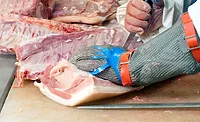Improving the Safety of Meal Kits: A Holistic Approach
Popularity of meal kits necessitates heightened food safety vigilance

Meal kits—consisting of portioned raw ingredients that are then assembled or cooked at home —have revolutionized the way we think about home cooking. These kits contain only the preportioned ingredients needed for a specific meal, as well as a recipe card with instructions suitable for the skill level of a home cook. With fresh ingredients and recipes curated by chefs, meal kits are advertised as a healthy, convenient, and sustainable option that reduces food waste. As the COVID-19 pandemic forced restaurants to shut down, the demand for meal kits increased. Following restrictions on indoor dining, many restaurants and grocery retailers adapted by selling meal kit take-out options. While food safety has long been integrated into restaurant and grocer regulations and trainings, as the use of meal kits continues to increase, it is important to be vigilant about ensuring that food safety protocols are carried over to the home as well.
Paralleling the increasing sales of meal kits, there was also an accompanying rise in food recalls by the U.S. Food and Drug Administration (FDA) associated with meal kits. From 2016 to 2020, there were four meal kit-related recalls in 2016, one in 2017, two in 2018, one in 2019, and eight in 2020. Common reasons for recalls of meal kits included contaminated ingredients at the source, mislabeling, and contamination with foreign materials. Further, the top five violation categories cited by the FDA at food facilities generally in 2020 were foreign supplier compliance, hazard identification and control, pest infestation and control, manufacturing controls, and personnel hygiene.
To improve food safety and reduce the risk of foodborne illness related to meal kits, it is important to evaluate operations using a farm-to-fork lens, not just ensuring the safety of the meal kit itself but also promoting proper handling and preparation by the customer. It is also important to develop a food safety plan, which is a systematic approach to identify potential food safety hazards and implement corresponding controls to prevent foodborne illness or injury. Included in this is a Hazard Analysis and Critical Control Points (HACCP) plan, which is a management system used to evaluate potential food safety hazards and develop controls at each step of the manufacturing process. The food safety plan also allows management to develop corrective actions, monitor procedures, and integrate a recall plan along the food supply chain. The critical areas to focus on for meal kits are ingredient sourcing, potential cross-contamination during processing, labeling, temperature control during transit, and consumer education.
Sourcing Ingredients
Properly sourcing ingredients builds a strong foundation for the overall safety of the meal kit by limiting the initial microbial load of ingredients before they enter the processing facility. While this is important for all ingredients included in the meal kit, it is particularly so for ingredients that are consumed without cooking or undergoing a microbial kill step (e.g., some fruits, vegetables, or other ready-to-eat products).
In addition, pathogenic bacteria can be transferred to raw produce from contaminated soil or surface water used for crop irrigation. This can be a particular concern if produce-growing operations are located in close proximity to livestock operations, are subject to land area runoff or flooding, or if manure is used as a fertilizer. Similarly, product harvesters with infectious illnesses or limited access to restrooms or proper handwashing stations while working can increase the potential of produce contamination.
Since microorganisms introduced in the field may be internalized into parts of the produce that cannot be adequately cleaned, prevention is the most effective method for control. While regulations often require that best practices be followed, compliance is not guaranteed. It is essential that meal kit producers be intentional about the sourcing of their ingredients and verify the practices used by suppliers. Where applicable, a Certificate of Analysis should be obtained from the supplier that includes verified characteristics of the food. Also, health and safety inspection records are often publicly available and can be requested from relevant state, local, or federal health authorities.
Limiting Cross-Contamination during Processing
Looking for quick answers on food safety topics?
Try Ask FSM, our new smart AI search tool.
Ask FSM →
Because many meal kits contain both components that will be cooked by the consumer and those that will be consumed raw, this creates a particular concern related to cross-contamination. For example, while Salmonella can be present on a raw chicken breast, the risk for foodborne illness can be reduced or eliminated by proper preparation and cooking by the consumer. However, if romaine lettuce (which is often consumed raw) is also included in that same meal kit, the risk of foodborne illness may be increased if the romaine is not properly protected from cross-contamination from the raw chicken product.
Meal kit manufacturers can control for foodborne illness risk associated with cross-contamination by reducing the potential for pathogenic growth, encouraging good health and hygiene among employees, utilizing appropriate disinfection techniques, and adequately separating raw ingredients from those that will be cooked.
It is vital that the meal kits be prepared and assembled in a facility that is designed and operated according to federal and state public health sanitation practices. Not only is this legally required,1–3 but it is also indispensable for reducing pathogenic growth. Preparing ingredients in refrigerated rooms can extend the lag phase and is another way to dampen bacterial growth. Employers should also encourage compliance with employee health and hygiene best practices by providing the necessary time, supplies, and training to workers. Work practices and scheduling should integrate tasks like handwashing, and policies should not penalize workers who stay home when sick. Food safety plans should acknowledge that pathogens will be present in the facility and include rigorous disinfection protocols. In addition, meal kit ingredients should be prepared, packaged, and stored separately from each other, and the exterior packaging should be disinfected prior to assembling the meal kit. Additional packaging should be used within the meal kit box to isolate ingredients that will be consumed raw from those that quite likely harbor pathogenic microbes (such as raw meats).
Allergen and Ingredient Labeling
The eight major food allergens (milk, eggs, fish, shellfish, tree nuts, peanuts, wheat, and soybeans) contribute to over 90 percent of food-allergic reactions in the United States. The Food Allergen Labeling and Consumer Protection Act of 2004 requires labeling on food products that contain an ingredient that is or contains protein from any of these major food allergen groups, either listed as an ingredient or after a “contains” statement. Between 2016 and 2020, over 3,200 food products were recalled due to at least one of the eight major food allergens not being declared or being mislabeled. Additional recalls have occurred when a food item is incorrectly labeled as containing an allergen when it does not.
Preventive controls, including allergen labeling to inform consumers, and sanitation controls to prevent allergen cross-contact during the assembly phase of meal kits must be addressed in the food safety plan. Preventing allergen cross-contact of ingredients in meal kits should include clear labels indicating the allergen, as well as separate packaging of allergenic ingredients. Labeling must be specific to the allergen to inform the consumer who has an allergy to any of the eight major food allergen groups, such as stating a specific tree nut rather than stating that the food product contains a tree nut. While labeling products that contain sesame is not currently required, it is recommended, as consumer concern over sesame as an allergen is becoming more common and sesame will be regulated in the United States as a food allergen starting in January 2023.
Additionally, labeling recalls may stem from other reasons that are unrelated to allergens, such as improper or missing expiration or “best by” dates, lot numbers, and nutritional facts. Correct food labeling is not only important to prevent major health risks to consumers but can also prevent extreme costs to companies when food recalls are avoided. On average, companies lose $10 million per recall in direct costs alone, which include costs to stop production, alert regulatory agencies and all parties along the supply chain, remove and destroy contaminated products, and identify the cause of the recall. Companies should include a monitoring step in the food safety plan where labeling is checked before it’s applied to the food product to avoid incorrect food labeling.
Temperature Controls during Transit
Meal kit delivery services specialize in providing fresh food to consumers with the convenience of doorstep delivery. Meal kits spend hours to days out of refrigeration as they travel from the processing facilities to customers’ homes, potentially encountering extreme temperatures in delivery trucks. As with any at-home delivery, it is common for the consumer to be away from home when the delivery arrives, further delaying the refrigeration of ingredients. Bacteria in perishable food can quickly multiply outside of refrigeration (at temperatures exceeding 40 °F). This can occur in as little as 2 hours during external temperatures below 90 °F, or in only 1 hour when external temperatures exceed 90 °F. In addition, higher moisture content (water activity, aw) in foods can promote bacteria growth.
It is therefore essential to be intentional with the meal kit packaging used, being mindful of the varying perishability of the ingredients and the climatic differences between and within delivery regions throughout the year. Ingredients that require refrigeration must be kept cold until the customer can unpack the meal kit. There may also be ingredients within the same meal kit that will undergo spoilage at low temperatures—these need to be adequately isolated from the coldest zones of the meal kit.
Particularly in warmer climates or regions with a warm summer season, additional measures can be taken to boost consumer confidence in temperature control of perishable food items. Consider including a temperature-sensitive indicator or sensor within the kit so that the customer can easily identify, upon opening their package, whether sufficiently low temperatures have been maintained throughout transit. In applicable regions, companies may also consider reaching out to customers seasonally to verify that scheduled delivery times are still ideal.
The use of appropriate packaging can provide additional benefits beyond temperature control. Using vacuum-sealed or modified-atmosphere packaging may assist in reducing bacterial growth for some foods and also increase the shelf life of ingredients prior to cooking. For some ingredients that are not typically refrigerated, treatment with an acidic solution (pH ≤ 4) could also prevent bacterial growth.
Educating Consumers on Food Handling
Unlike foods prepared in a facility or commercial kitchen, meal kits are unique in that the customer is ultimately responsible for cooking the meal. While preparation adds a fun experience that cannot be achieved through take-out meals, it also creates a dynamic where the safety of the product consumed depends on the customer’s properly storing and preparing the foods. Foodborne illness causes an estimated 48 million illnesses and 3,000 deaths in the United States each year. Food that is mishandled by the consumer through improper refrigeration, delayed consumption, or inadequate cooking and reheating temperatures can result in foodborne illness.
Education in proper food handling techniques can minimize the occurrence of foodborne illness. The U.S. Department of Agriculture has recommended four steps to prevent foodborne illness at the consumer level: clean (wash hands and surfaces often), separate (don’t cross-contaminate), cook (cook to proper temperatures), and chill (refrigerate properly). Following these steps is critical to avoiding foodborne illnesses that may result from improper consumer food-handling of ingredients in meal kits. Meal kit manufacturers play a vital role in communicating these proper food handling techniques to consumers.
Specifically, consumers should be mindful to wash their hands before and after handling food and to use clean disposable gloves during food handling if they have infections or skin abrasions. They should be aware of the potential for cross-contamination, especially with items (cutting boards, knives) and surfaces (dishcloths, countertops, faucets) that come into contact with raw meat, poultry, fish, and eggs. These must be thoroughly washed in hot, soapy water after each use to prevent cross-contamination. Cooked food products should not share utensils or platters with raw food products. In addition, cooking food products to the proper temperature, especially raw meat and poultry products, is critical to avoiding foodborne illness. Along with initial cooking temperatures, consumers should be made aware of proper reheating techniques for any leftovers from the meal kit. Consumers of meal kits should be advised to refrigerate perishable food products immediately upon arrival. Meal kit manufacturers can aid consumers by communicating safe time limits to keep home-refrigerated food from spoiling, as well as storage practices for leftovers.
There are several additional actions meal kit manufacturers can take to encourage customers to practice safe food handling at home. While some meal kit companies provide food safety tips on their website, also including this information directly with the ingredients in the meal kit is a more effective way to reach customers. Use stickers or other labels on the ingredient packaging to communicate use-by dates or necessary storage temperatures. Consider including a free precalibrated, instant-read food thermometer with sign-up so that customers have the necessary tool to easily determine whether safe cooking temperatures have been achieved. Proper food handling recommendations (using separate cutting boards and knives for raw meat versus raw vegetables; washing contaminated supplies in hot, soapy water; achieving a certain cooking temperature) can also be integrated into the recipe steps as gentle reminders.
Conclusion
Meal kits mark a major innovation by allowing home cooks to prepare restaurant-quality meals, save on shopping time, and reduce food waste with preportioned ingredients. Many things can be done to ensure the safety of the meal kit product in each phase of the supply chain.4 It is important to consider the unique characteristics of your ingredients, region, and customer base and provide flexible and specific solutions that meet these needs—packaging designed for raw pork may not be ideal for a peanut garnish, and the temperature control needs for a package shipped to Boston in December may differ from a package shipped to Tucson, Arizona, in July. The safety of the meal kit may ultimately depend on the precautions taken by the consumer when they prepare their meal. This is an opportunity to share the food safety knowledge that is integral to production facilities and restaurants with home cooks.
References
- https://www.fda.gov/drugs/pharmaceutical-quality-resources/current-good-manufacturing-practice-cgmp-regulations.
- https://www.fsis.usda.gov/guidelines/2020-0009.
- https://www.cdc.gov/foodsafety/communication/food-safety-meal-kits.html.
- https://www.food-safety.com/articles/6809-whos-managing-the-safety-of-food-delivery.
Neva Jacobs, M.S.P.H., CIH, and Ania Urban, Ph.D., M.P.H., are health scientists with Cardno ChemRisk, a consulting firm that provides scientific advice to governments, corporations, law firms, and scientific/professional organizations. This article was co-authored by a team of Cardno ChemRisk staff: Dan Dinh, Melinda Donnell, Alexandra Schulte, and Ricardo Ramirez. They have expertise related to exposure and risk assessments for food products as well as certifications in HACCP planning and ServSafe.








